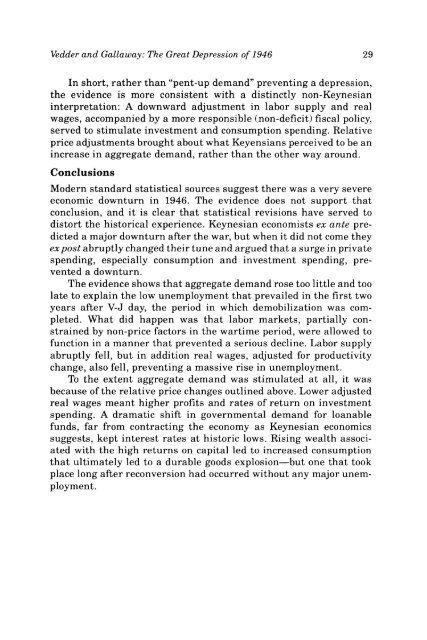Review of Austrian Economics - The Ludwig von Mises Institute
Review of Austrian Economics - The Ludwig von Mises Institute
Review of Austrian Economics - The Ludwig von Mises Institute
Create successful ePaper yourself
Turn your PDF publications into a flip-book with our unique Google optimized e-Paper software.
Vedder and Gallaway: <strong>The</strong> Great Depression <strong>of</strong> 1946 29<br />
In short, rather than "pent-up demand" preventing a depression,<br />
the evidence is more consistent with a distinctly non-Keynesian<br />
interpretation: A downward adjustment in labor supply and real<br />
wages, accompanied by a more responsible (non-deficit) fiscal policy,<br />
served to stimulate investment and consumption spending. Relative<br />
price adjustments brought about what Keyensians perceived to be an<br />
increase in aggregate demand, rather than the other way around.<br />
Conclusions<br />
Modern standard statistical sources suggest there was a very severe<br />
economic downturn in 1946. <strong>The</strong> evidence does not support that<br />
conclusion, and it is clear that statistical revisions have served to<br />
distort the historical experience. Keynesian economists ex ante predicted<br />
a major downturn after the war, but when it did not come they<br />
ex post abruptly changed their tune and argued that a surge in private<br />
spending, especially consumption and investment spending, prevented<br />
a downturn.<br />
<strong>The</strong> evidence shows that aggregate demand rose too little and too<br />
late to explain the low unemployment that prevailed in the first two<br />
years after V-J day, the period in which demobilization was completed.<br />
What did happen was that labor markets, partially constrained<br />
by non-price factors in the wartime period, were allowed to<br />
function in a manner that prevented a serious decline. Labor supply<br />
abruptly fell, but in addition real wages, adjusted for productivity<br />
change, also fell, preventing a massive rise in unemployment.<br />
To the extent aggregate demand was stimulated at all, it was<br />
because <strong>of</strong> the relative price changes outlined above. Lower adjusted<br />
real wages meant higher pr<strong>of</strong>its and rates <strong>of</strong> return on investment<br />
spending. A dramatic shift in governmental demand for loanable<br />
funds, far from contracting the economy as Keynesian economics<br />
suggests, kept interest rates at historic lows. Rising wealth associated<br />
with the high returns on capital led to increased consumption<br />
that ultimately led to a durable goods explosion—but one that took<br />
place long after reconversion had occurred without any major unemployment.

















